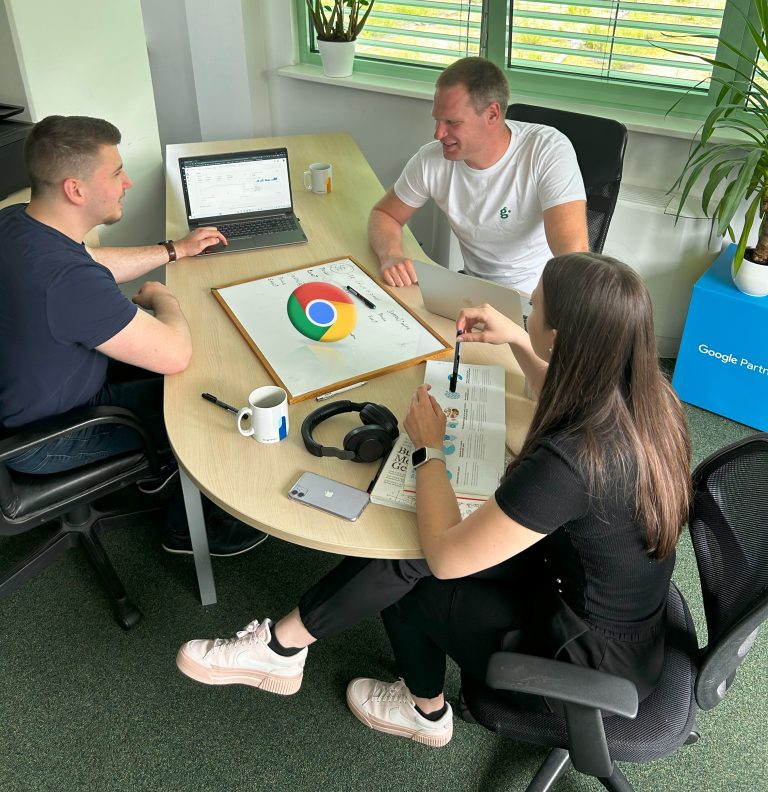Put Your Fears to Rest
At Goodish, we understand that migrating to Google Analytics 4 from Universal Analytics is risky and that you may have concerns about the process.
Maximize Insights: Expert GA4 Configuration for Your Business



From Pribly Ventures LLC
With cross-device tracking and custom event tracking, GA4 provides a complete picture of how users interact with your business online.This can help you identify opportunities to improve the customer experience and increase conversions.
Real-time data and advanced analysis capabilities allow you to quickly and confidently make data-driven decisions.
GA4's privacy-first features give you peace of mind that you're collecting data ethically and responsibly.
GA4 is seamlessly integrated with other Google tools like Google Ads and BigQuery.This gives you a holistic view of your marketing efforts and their impact on your overall business performance.
Overall, upgrading to GA4 can help you better understand and improve your online performance and give you the tools you need to drive growth and success for your business.
At Goodish, we understand that migrating to Google Analytics 4 from Universal Analytics is risky and that you may have concerns about the process.
"Their delivery was within budget and on time, even though we had a very tight schedule."

Co-founder & CEO at Loop Email
Expertise: Our team of Google Analytics-certified experts has worked with GA4 since the beta version was released and has successfully helped more than 100 businesses migrate to the platform.
Proven success: With more than 100 successful GA4 migrations under our belt, we have a track record of helping businesses like yours upgrade to GA4 and realize the platform’s benefits.
Dedicated support: We’ll be there to answer your questions and provide guidance every step of the way.
Overall, Goodish is the trusted choice for businesses upgrading to Google Analytics. Contact us today to learn more about how we can help you make the most of this powerful platform.

By understanding how users interact with your business across multiple devices, you can optimize the customer experience and improve conversions.
With GA4’s privacy-first features, you can feel confident that you’re collecting data ethically and responsibly, which is increasingly important as consumers become more concerned about their online privacy.
With GA4’s advanced machine learning algorithms, you can trust that the data you’re seeing is accurate and reliable, allowing you to make data-driven decisions confidently.
With GA4’s real-time data, you can see how users interact with your business in near real-time and quickly make data-driven decisions.
By tracking custom events on your website or app, you can understand what actions are most important to your business and optimize your marketing efforts accordingly.
GA4 is designed to provide value for businesses of all sizes and industries. Upgrade to GA4 today and start realizing the benefits for your business.
Here’s how we’ll work together to migrate your business to GA4:
Throughout the process, we’ll be there to answer your questions and provide guidance every step of the way. Let us handle the technical details so you can focus on growing your business. Contact us today to get started on your GA4 migration journey.
One of the key differentiators is our team of GA4 experts, who have extensive experience in successfully migrating businesses to GA4.
We have a proven track record of successful migrations, and our team is dedicated to providing our clients with the highest level of support throughout the process.
Yes, Goodish can assist with custom event tracking in GA4. Custom events are a vital feature of GA4 that allow you to follow specific user actions on your website or app, such as button clicks or form submissions. By tracking these events, you can gain a deeper understanding of your users’ behavior and identify opportunities for improvement.
Goodish’s team of GA4 experts can help you set up custom event tracking in GA4, including identifying the most important events for your business and implementing the necessary tracking code. We can also help you analyze your custom event data and identify trends and patterns that can inform your marketing and optimization efforts.
No, views are replaced by ‘data streams’. A GA4 account only has an account and property level. Data streams are in a way much more versatile as they can connect data from the web, iOS, Android, and even server to server.
First and foremost, GA4 provides a wealth of data and insights that can inform your marketing efforts. By migrating to GA4, you can access data on your users’ cross-channel journeys, advanced funnel analysis, flexible attribution modeling, and more.
This data can help you better understand your customers and identify opportunities for optimization and improvement. In addition, Goodish’s team of GA4 experts can guide how to use this data best to inform your marketing efforts, including through custom events and advanced segmentation.
Google Analytics 4 (GA4) is the latest version of Google’s analytics platform. It was designed to provide a more comprehensive and data-driven approach to understanding customer behavior across channels and devices. GA4 includes several new features and capabilities unavailable in Universal Analytics, including cross-channel user journey analysis, advanced funnel analysis, flexible attribution modeling, and predictive analytics.
It also provides user-level data and allows for the tracking of custom events, enabling businesses to gain a deeper understanding of their customer’s behavior. Overall, GA4 represents a significant update to Google’s analytics platform and offers several new features and capabilities that can help businesses better understand and optimize their marketing efforts.
Yes, it is possible to use both Universal Analytics and Google Analytics 4 (GA4) simultaneously. This is known as “dual tagging,” and it involves implementing tracking code for both Universal Analytics and GA4 on your website or app. Dual tagging can be helpful in some cases, such as when you want to continue using Universal Analytics while also taking advantage of the new features and capabilities of GA4.
It can also be helpful if you want to transition to GA4 gradually, as it allows you to collect data on both properties while you make the transition. However, it’s important to note that dual tagging can add complexity to your tracking setup and may require additional resources to maintain and manage. Ultimately, whether or not dual tagging is the right approach for your business will depend on your specific needs and goals.
You can use Google Tag Manager (GTM) with Google Analytics 4 (GA4). GTM is a tag management system that allows you to add tracking and marketing tags to your website or app without modifying the code directly. This can be useful when implementing GA4, as it will enable you to manage your tracking code and tags in a centralized location and makes it easier to make updates or changes.
To use GTM with GA4, you must create a new GA4 tag in GTM and configure it according to your tracking needs. GTM also provides features and capabilities that can help you manage and optimize your GA4 implementation, such as debugging tools, tag-firing triggers, and data layer variables. Overall, GTM can be helpful when working with GA4 and streamline the tracking and tag management process.

Your Guides for Techy Side of Marketing
Where to find us:
Goodish, d.o.o.
Podbreznik 15,
8000 Novo mesto,
Slovenia, EU

All rights reserved © Goodish
"Working with Goodish was great. They fixed a goal tracking / data integrity issue that had several other experts stumped. I wouldn’t hesitate to work with them again in the future"